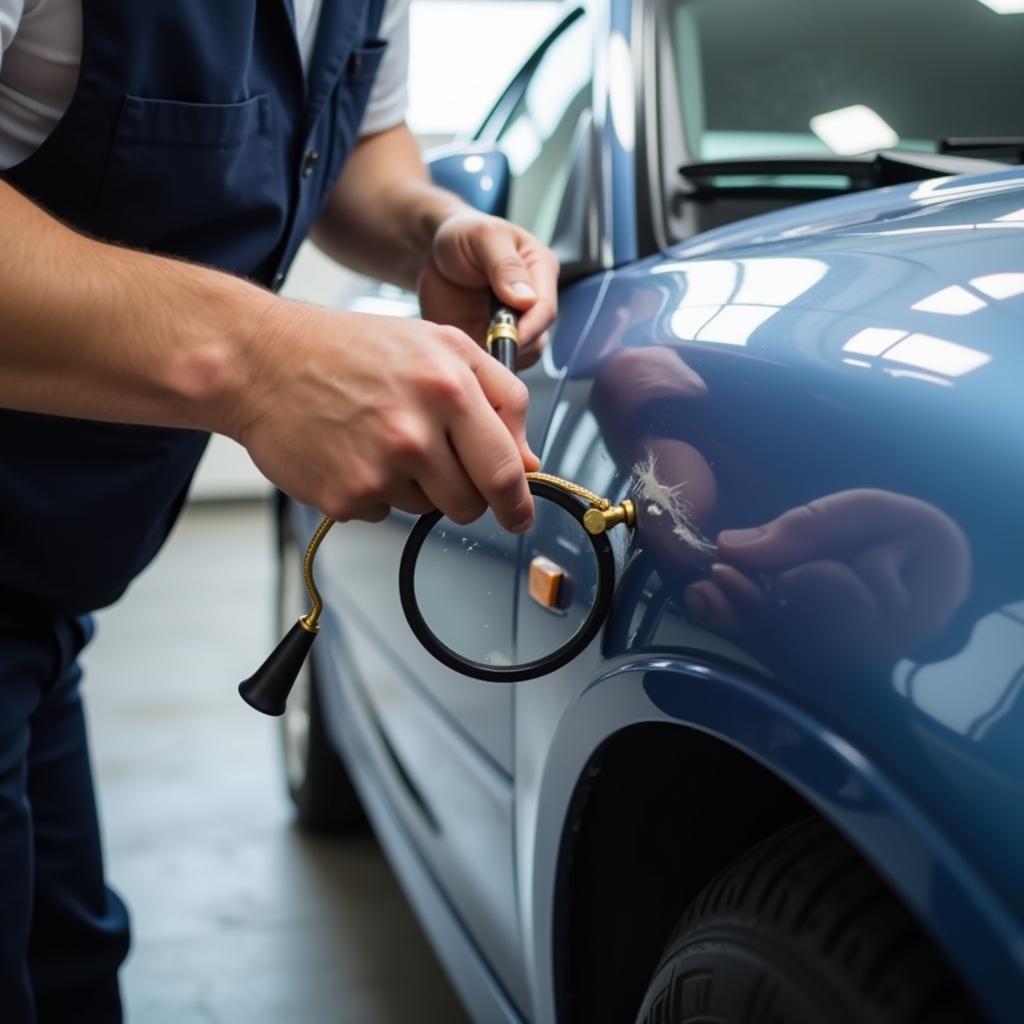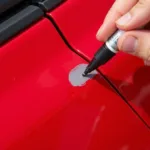Minor paint damage, like scratches and chips, are an inevitable part of car ownership. But don’t despair! Fixing these blemishes is often easier than you think. This guide will walk you through how to repair minor paint damage on your car, saving you a trip to the body shop and keeping your vehicle looking its best.
Repairing minor paint damage yourself can be a rewarding and cost-effective way to maintain your car’s appearance. Whether you’re dealing with a small scratch, a stone chip, or scuff marks, there are DIY solutions available. Understanding the different types of damage and the appropriate repair methods is crucial for achieving professional-looking results. Let’s dive in.
Assessing the Damage: The First Step in Car Paint Repair
Before you begin any repair, it’s essential to assess the extent of the damage. This will determine the appropriate repair method and the materials you’ll need.
Types of Minor Paint Damage
- Scratches: These can range from light clear coat scratches to deeper ones that penetrate the base coat.
- Chips: Small pieces of paint chipped away, often caused by rocks or road debris.
- Scuffs: Superficial damage usually affecting only the clear coat, often caused by minor bumps or scrapes.
Determining the depth of the damage is crucial. A simple test involves running your fingernail across the scratch. If your nail catches, it likely penetrates beyond the clear coat and requires more extensive repair.
After assessing the type and depth of the damage, you can choose the right repair method. For very minor scratches, a simple polish might suffice. Deeper scratches and chips will require touch-up paint and clear coat.
This first step sets the stage for a successful repair. Taking the time to carefully assess the damage will save you time and effort in the long run.
 Assessing Car Paint Damage before Repair
Assessing Car Paint Damage before Repair
DIY Repair Methods for Minor Car Paint Damage
Several DIY methods are effective for repairing minor car paint damage. Choosing the right one depends on the severity of the damage.
Fixing Minor Scratches and Scuffs
For very superficial damage, a polishing compound can often restore the clear coat’s shine. Apply a small amount of polish to a microfiber cloth and gently rub the affected area in a circular motion.
blending paint car repair can be a tricky but essential part of the repair process, especially for larger scratches or chips.
Repairing Paint Chips
Chips require a bit more work. First, clean the area thoroughly with rubbing alcohol. Then, apply touch-up paint to the chip using a fine-tipped brush or a touch-up pen. Allow the paint to dry completely before applying a layer of clear coat.
no paint car repair, while useful for certain types of damage like small dents, is not ideal for scratches or chips that penetrate the paint layers.
When to Seek Professional Help
While many minor repairs can be done at home, deeper scratches or damage to the metal underneath require professional attention. Don’t hesitate to consult a qualified auto body shop for more significant repairs.
“Accurate color matching is essential for a seamless repair,” advises John Smith, Lead Technician at Smith Auto Body. “If you’re unsure about matching the paint yourself, a professional can ensure a perfect blend.”
Tools and Materials for Car Paint Repair
Having the right tools and materials is essential for a successful repair.
Essential Repair Kit
- Rubbing Alcohol: For cleaning the damaged area.
- Microfiber Cloths: For applying and buffing polish.
- Polishing Compound: For removing minor scratches and restoring shine.
- Touch-Up Paint: For filling in chips and deeper scratches.
- Clear Coat: For protecting the repaired area and restoring the original finish.
- Fine-tipped Brushes or Touch-Up Pens: For precise application of touch-up paint.
- Sandpaper (fine grit): For smoothing the repaired area (use with caution).
- Masking Tape: To protect surrounding areas when painting.
car paint chip repair mobile services are a convenient option for those who prefer professional assistance without the hassle of visiting a traditional body shop.
Preventing Future Paint Damage
Protecting your car’s paint from future damage is the best way to keep it looking pristine.
Protective Measures
- Regular Washing and Waxing: Keeps the paint protected and helps prevent minor scratches.
- Parking in Covered Areas: Shields your car from the elements and reduces the risk of damage from falling objects.
- Using Paint Protection Film (PPF): A clear film applied to vulnerable areas to protect against rock chips and scratches.
“Prevention is always the best strategy,” says Maria Garcia, Automotive Detailing Specialist. “Regular care and protective measures can significantly reduce the risk of paint damage.”
how to repair minor car paint damage might seem daunting, but with the right information and tools, it’s a manageable task.
Conclusion
Knowing how to repair minor paint damage on your car can save you money and keep your vehicle looking great. By assessing the damage, choosing the right repair method, and using the proper tools and materials, you can achieve professional-looking results. Remember, prevention is key, so take steps to protect your car’s paint from future damage.
FAQ
- Can I repair any type of paint damage myself? Minor scratches, chips, and scuffs are often manageable DIY projects. Deeper damage or damage to the underlying metal requires professional repair.
- Where can I find touch-up paint that matches my car’s color? Your car’s owner’s manual should list the paint code. You can also check the information sticker inside the driver’s side doorjamb. Automotive paint suppliers can then mix the exact color for you.
- How long does touch-up paint take to dry? Drying time varies depending on the type of paint and environmental conditions. Always follow the manufacturer’s instructions.
- What if the touch-up paint doesn’t perfectly match my car’s color? Slight variations in color can occur. Professional color matching is recommended for the best results.
- Is it necessary to apply clear coat after touch-up paint? Yes, clear coat protects the repaired area, adds shine, and helps blend the repair with the surrounding paint.
- How often should I wax my car? Waxing every three to six months provides good protection.
- What is the best way to remove minor scratches? A polishing compound and a microfiber cloth are usually effective for removing superficial scratches.
doncaster mobile car paint repair offers convenient and professional repair solutions for those in the Doncaster area.
Common Car Paint Damage Scenarios
- Scenario 1: Light Scratch from a Key: Use a polishing compound and a microfiber cloth to buff out the scratch.
- Scenario 2: Stone Chip on the Hood: Clean the area with rubbing alcohol, apply touch-up paint, and finish with a layer of clear coat.
- Scenario 3: Scuff Mark on the Bumper: A polishing compound is usually sufficient to remove superficial scuff marks.
Further Reading and Resources
- Check out our article on how to repair minor car paint damage for more detailed instructions.
Need assistance? Contact us via WhatsApp: +1(641)206-8880 or Email: [email protected]. We have a 24/7 customer support team ready to help.


